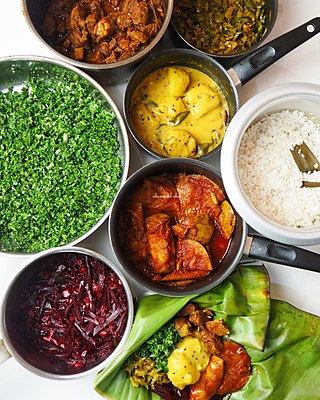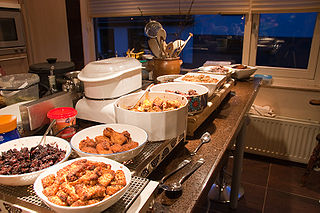
Malay cuisine is the traditional food of the ethnic Malays of Southeast Asia, residing in modern-day Malaysia, Indonesia, Singapore, Brunei, Southern Thailand and the Philippines as well as Cocos Islands, Christmas Island, Sri Lanka and South Africa.

Pakora is a fritter originating from the Indian subcontinent. They are sold by street vendors and served in restaurants across South Asia. It often consists of vegetables such as potatoes and onions, which are coated in seasoned gram flour batter and deep fried.

Korokke is a Japanese deep-fried yōshoku dish originally related to a French dish, the croquette. Korokke is made by mixing cooked chopped meat, seafood, or vegetables with mashed potato or white sauce, usually shaped like a flat patty, rolling it in wheat flour, eggs, and Japanese-style breadcrumbs, then deep-frying this until brown on the outside.

Sri Lankan cuisine is known for its particular combinations of herbs, spices, fish, vegetables, rices, and fruits. The cuisine is highly centered around many varieties of rice, as well as coconut which is a ubiquitous plant throughout the country. Seafood also plays a significant role in the cuisine, be it fresh fish or preserved fish. As a country that was a hub in the historic oceanic silk road, contact with foreign traders brought new food items and cultural influences in addition to the local traditions of the country's ethnic groups, all of which have helped shape Sri Lankan cuisine. Influences from Indian, Indonesian and Dutch cuisines are most evident with Sri Lankan cuisine sharing close ties to other neighbouring South and Southeast Asian cuisines.

Kuih are bite-sized snack or dessert foods commonly found in Southeast Asia and China. It is a fairly broad term which may include items that would be called cakes, cookies, dumplings, pudding, biscuits, or pastries in English and are usually made from rice or glutinous rice. In China, where the term originates from, kueh or koé (粿) in the Min Nan languages refers to snacks which are typically made from rice but can occasionally be made from other grains such as wheat. The term kuih is widely used in Malaysia, Brunei, and Singapore, kueh is used in Singapore and Indonesia, kue is used in Indonesia only, all three refer to sweet or savoury desserts.

Kue is an Indonesian bite-sized snack or dessert food. Kue is a fairly broad term in Indonesian to describe a wide variety of snacks including cakes, cookies, fritters, pies, scones, and patisserie. Kue are made from a variety of ingredients in various forms; some are steamed, fried or baked. They are popular snacks in Indonesia, which has the largest variety of kue. Because of the countries' historical colonial ties, Koeé (kue) is also popular in the Netherlands.

A banana fritter is a fritter made by deep frying battered banana or plantain in hot cooking oil. It is a common dish across Southeast Asia and South India.

Corn fritters are fried cakes of a dough or batter made of, or containing a featured quantity of maize (corn). Originating in Native American cuisine, they are a traditional sweet and savory snack in the Southern United States, as well as Indonesia where they are known as perkedel jagung or bakwan jagung.

Javanese cuisine is the cuisine of Javanese people, a major ethnic group in Indonesia, more precisely the province of Central Java, Yogyakarta and East Java.

A great variety of cassava-based dishes are consumed in the regions where cassava is cultivated. Manihot esculenta is a woody shrub of the spurge family, Euphorbiaceae, native to South America, from Brazil, Paraguay and parts of the Andes.

Regional street food is street food that has commonalities within a region or culture.

Bakwan is a vegetable fritter or gorengan that are commonly found in Indonesia. Bakwan are usually sold by traveling street vendors. The ingredients are vegetables; usually beansprouts, shredded cabbages and carrots, battered and deep fried in cooking oil. To achieve crispy texture, the batter uses a mixture of flour, corn starch and sago or tapioca. In West Java bakwan is known as bala-bala and in Semarang is called badak. It is similar to Japanese yasai tenpura, Korean pajeon, Bruneian cucur, Burmese A-kyaw or Filipino ukoy.

Malaysian Indian cuisine, or the cooking of the ethnic Indian communities in Malaysia, consists of adaptations of authentic dishes from India, as well as original creations inspired by the diverse food culture of Malaysia. Because the vast majority of Malaysia's Indian community are of South Indian descent, and are mostly ethnic Tamils who are descendants of immigrants from a historical region which consists of the modern Indian state of Tamil Nadu and Sri Lanka's Northern Province, much of Malaysian Indian cuisine is predominantly South Indian inspired in character and taste. A typical Malaysian Indian dish is likely to be redolent with curry leaves, whole and powdered spice, and contains fresh coconut in various forms. Ghee is still widely used for cooking, although vegetable oils and refined palm oils are now commonplace in home kitchens. Before a meal it is customary to wash hands as cutlery is often not used while eating, with the exception of a serving spoon for each respective dish.

Betawi cuisine is rich, diverse and eclectic, in part because the Betawi people that create them were composed from numbers of regional immigrants that came from various places in the Indonesian archipelago, as well as Chinese, Indian, Arab, and European traders, visitors and immigrants that were attracted to the port city of Batavia since centuries ago.

Burmese fritters are traditional fritters consisting of vegetables or seafood that have been battered and deep-fried. Assorted fritters are called a-kyaw-sone. Burmese fritters are generally savory, and often use beans and pulses, similar to South Asian vada.

Indo cuisine is a fusion cooking and cuisine tradition, mainly existing in Indonesia and the Netherlands, as well as Belgium, South Africa and Suriname. This cuisine characterized of fusion cuisine that consists of original Indonesian cuisine with Eurasian-influences—mainly Dutch, also Portuguese, Spanish, French and British—and vice versa. Nowaday, not only Indo people consume Indo cuisine, but also Indonesians and Dutch people.









































